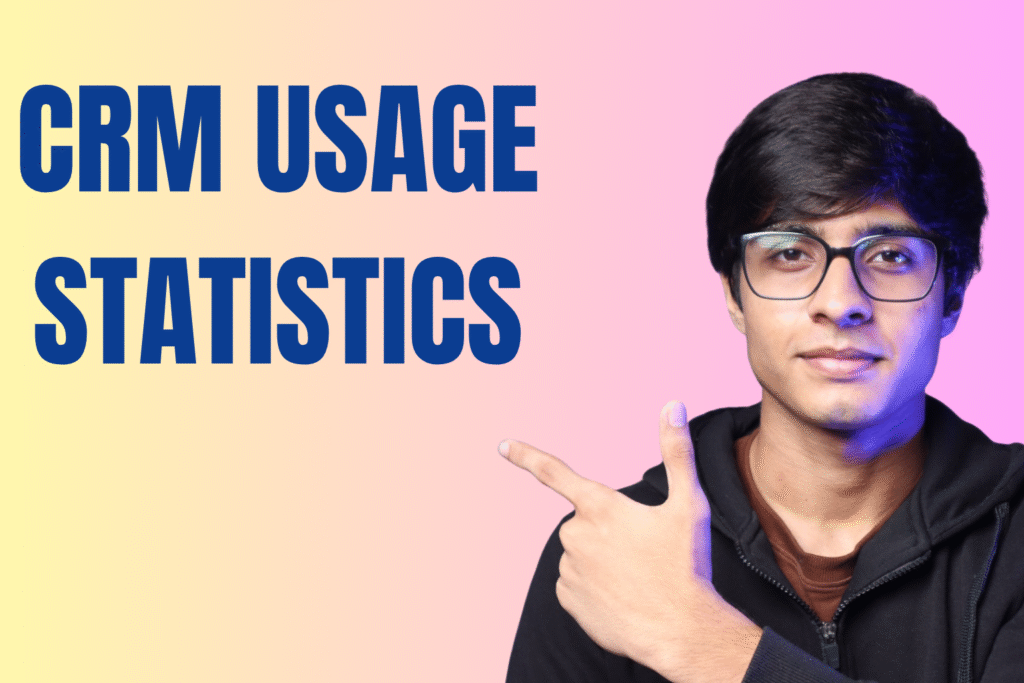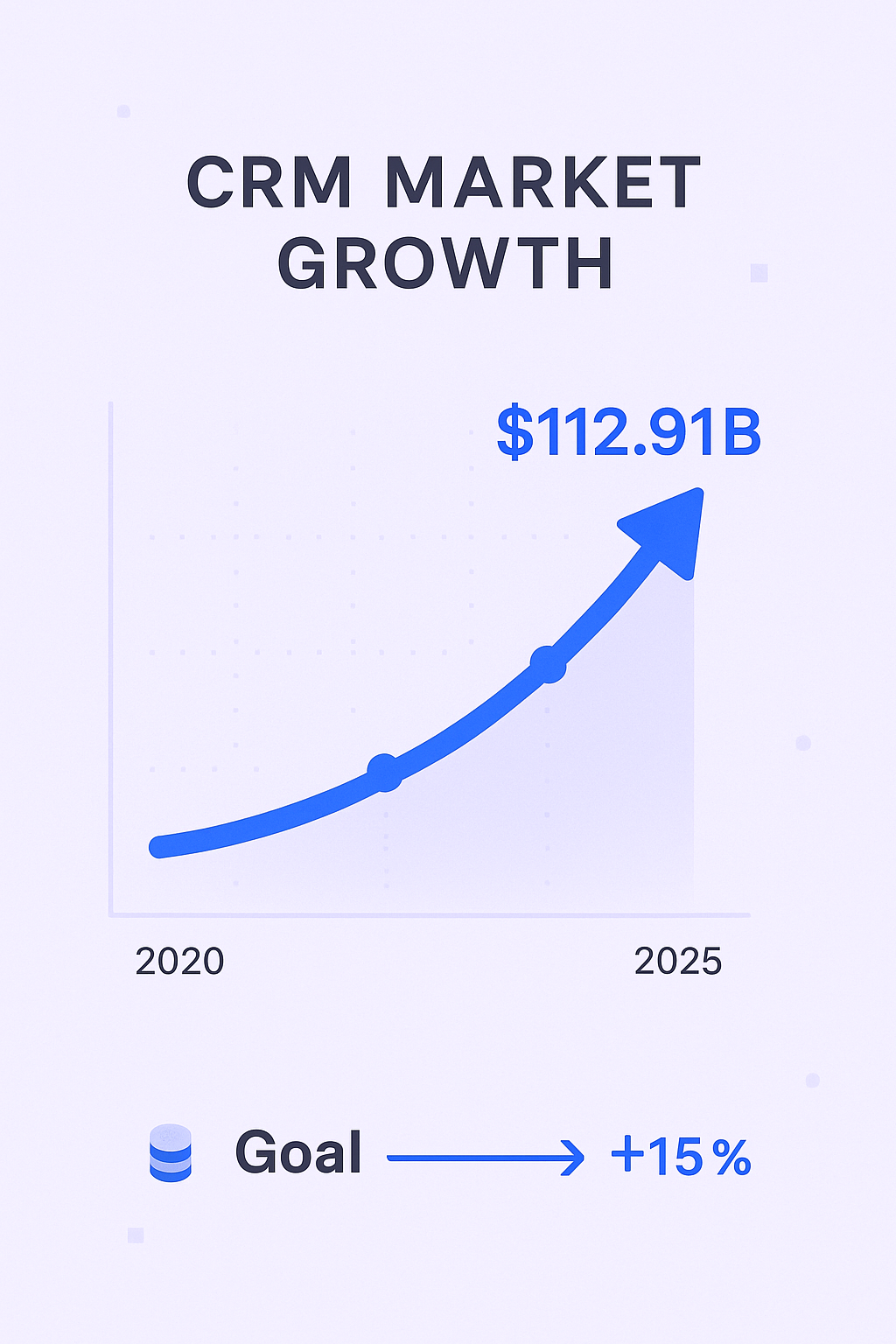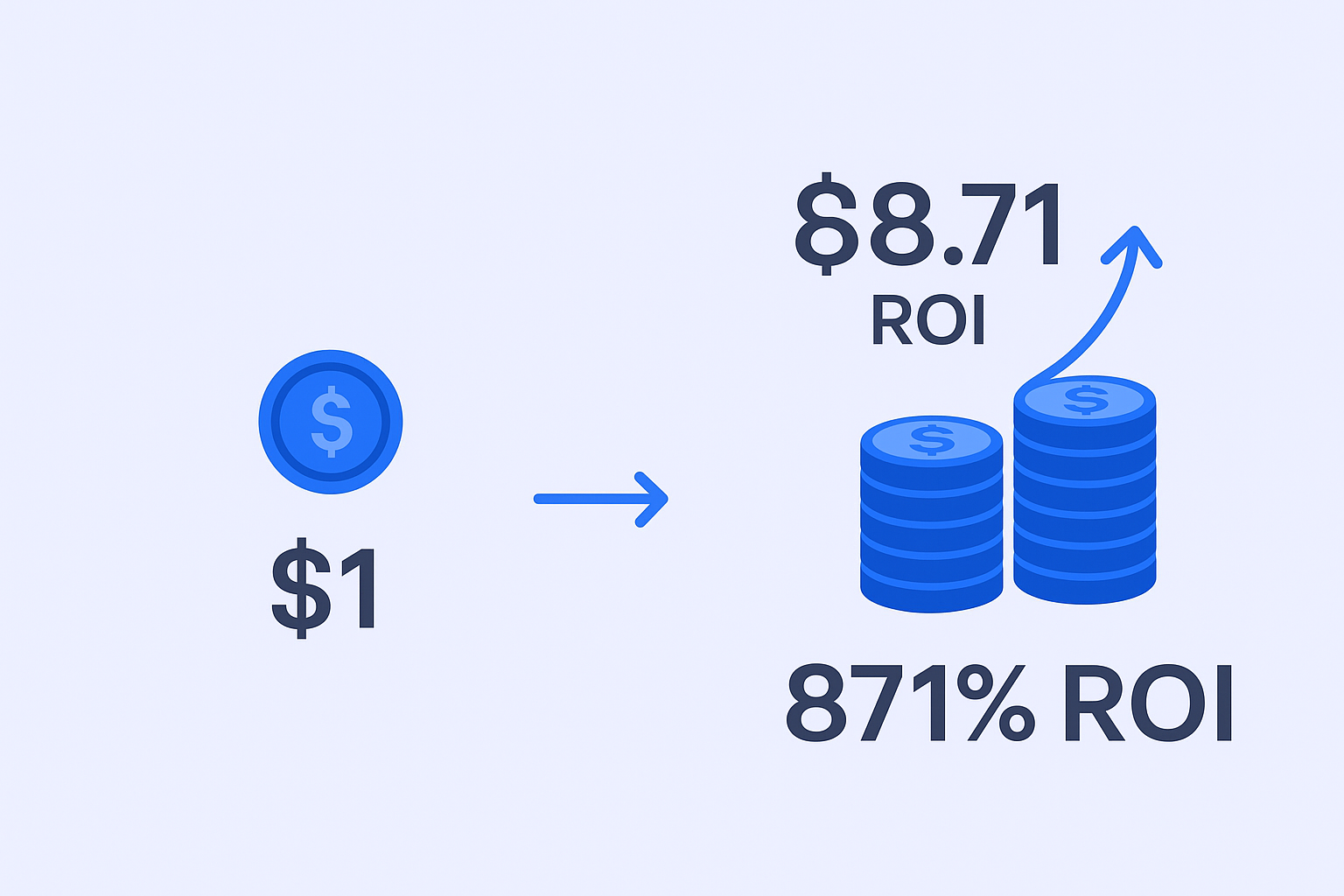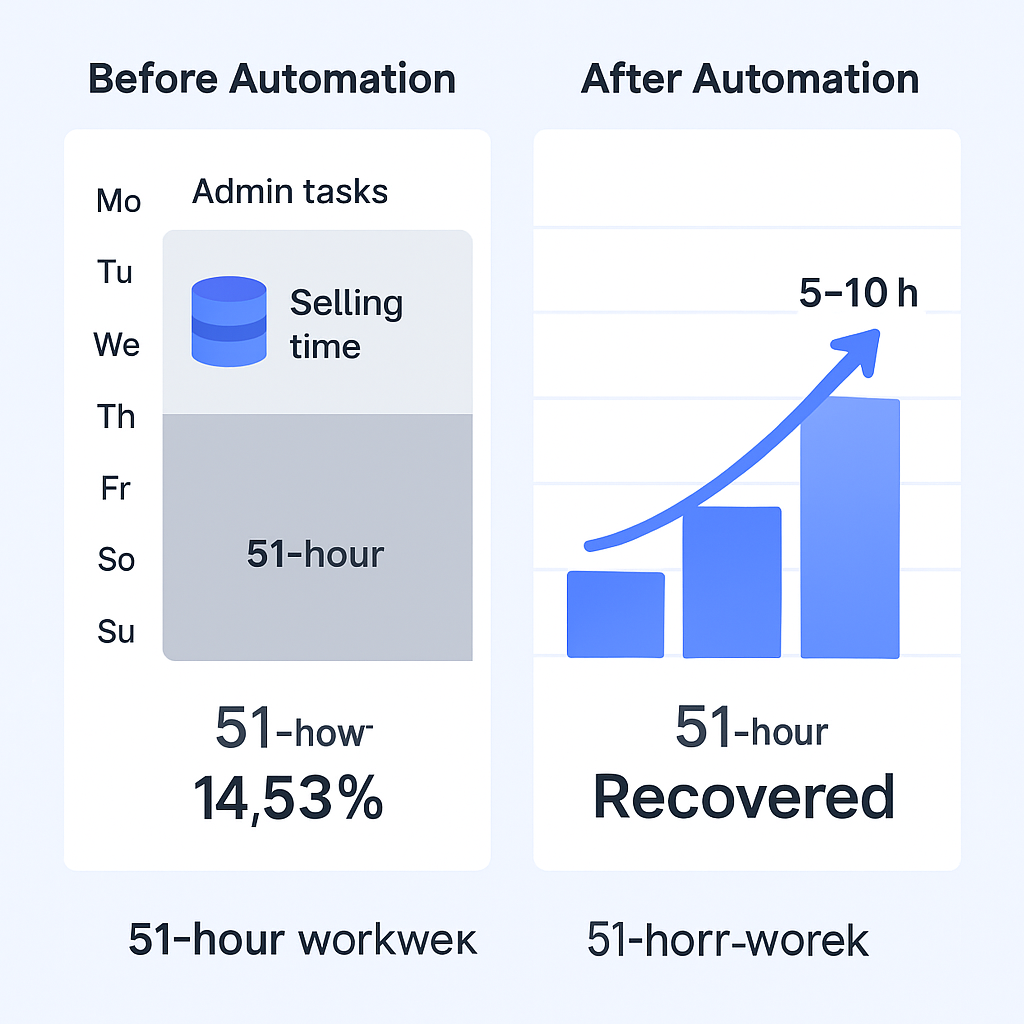- blog
- Statistics
- CRM Usage Statistics 2025: AI & Automation Insights

Table of Contents
CRM Usage Statistics
- Global CRM systems market is expected to hit between $97.90 billion and $112.91 billion in 2025
- Global AI in CRM market is projected to reach $11.04 billion in 2025, driving intelligent automation
- 91% of businesses with more than 10 employees currently use a CRM system for sales management
- CRM software delivers $8.71 for every $1 spent, representing an 871% return on investment
- Businesses using CRM report an average 29% to 41% increase in sales revenue after implementation
- Lead conversion rates can increase by up to 300% with a well-utilized CRM system
- Companies using CRM are 86% more likely to exceed their sales goals than those without
- Sales reps spend only 28% to 53% of their week actually selling, with the rest on administrative tasks
- Automation saves employees an average of 5 to 10 hours per week previously lost to manual data entry
- 65% of salespeople using mobile CRM meet their quotas, compared to only 22% without mobile access
- 65% of businesses have already adopted CRM systems with generative AI, projected to exceed 70% by end of 2025
- Businesses using generative AI in their CRM are 83% more likely to exceed their sales goals
- AI-driven CRM systems lead to 30-50% faster response times to customer inquiries and leads
- 79% of opportunity-related data gathered by sales reps is never entered into a CRM due to manual entry friction
- Companies can lose up to 27% of revenue due to inaccurate or incomplete customer data in their CRM
You’re drowning in spreadsheets. Manual data entry eats your afternoon. And somewhere between logging calls and updating records, the hot lead you meant to follow up with yesterday goes cold.
Sound familiar?
Here’s the thing—your CRM system shouldn’t feel like punishment. In 2025, the smartest sales teams aren’t just tracking contacts anymore. They’re leveraging AI-powered platforms that do the heavy lifting, recover 5-10 hours per week, and boost conversion rates by up to 300%.
These aren’t projections. They’re proven CRM statistics showing how the right technology transforms chaos into revenue.
Let’s dive into the numbers that matter—so you can skim what you need, make a decision, and get back to actually selling.
The Core CRM Statistics for 2025
The CRM market isn’t growing. It’s exploding.
In 2025, the global CRM systems market is expected to hit between $97.90 billion and $112.91 billion. That’s not a typo—nearly $100 billion in annual investment. This isn’t discretionary spending. For modern businesses, CRM software has become foundational infrastructure, right next to your email and phone system.

What’s driving this massive growth? Artificial intelligence. The global AI in CRM market size alone is projected to reach $11.04 billion in 2025. Companies aren’t just buying databases anymore—they’re investing in predictive intelligence, automated workflows, and digital assistants that make sales teams smarter and faster.
Here’s what adoption looks like on the ground:
- 91% of businesses with more than 10 employees currently use a CRM system
- 94% of tech companies have adopted CRM solutions
- 87% of companies use cloud-based CRM for flexibility and remote access
- Even 71% of small businesses (500 or fewer employees) rely on CRM systems
Think about that. If you’re not using modern CRM systems, you’re competing against nine out of ten businesses that are. They have centralized customer data. They have automation. They have AI predicting which leads will close.
Bottom line: CRM adoption isn’t optional anymore—it’s the price of entry. The $11 billion AI investment means the gap between teams using intelligent systems and those stuck with spreadsheets is widening fast.
CRM Benefits Statistics
Let’s cut to what matters most: money made and time recovered.
The ROI Nobody Can Ignore
On average, CRM software delivers $8.71 for every $1 spent. That’s an 871% return on investment. Show me another business tool with that kind of proven track record.
But it gets better:

- Businesses using CRM report an average 29% increase in sales revenue, with some studies showing jumps up to 41%
- Lead conversion rates can increase by up to 300% with a well-utilized CRM system
- Companies using CRM are 86% more likely to exceed their sales goals than those who skip it
- Sales forecast accuracy improves by up to 42% after implementation
That 300% conversion increase? It comes from consistent follow-up, accurate lead scoring, and timely personalized outreach—all powered by organized customer relationship management.
🎯 Target Decision-Makers Who Actually Buy
Skip the CRM complexity. Our LinkedIn outbound delivers verified leads with 30-50% faster response rates.
Winning Back Your Week
Here’s the stat that should wake everyone up: sales reps spend only 28% to 53% of their week actually selling. The rest? Meetings, admin work, and manual CRM updates.
In fact, approximately 14 hours out of a 51-hour work week gets wasted on non-selling administrative tasks like manual data entry. That’s nearly three full workdays every week, lost to paperwork.

Modern automation solves this:
- Automation saves employees an average of 5 to 10 hours per week
- The average sales cycle shortens by 8 to 14 days with CRM efficiency improvements
- 65% of salespeople using mobile CRM meet their quotas, compared to only 22% without mobile access
Think about what you could do with an extra 10 hours each week. More prospecting calls. Deeper discovery conversations. Actually closing deals instead of logging them.
⚡ Automate Outreach, Not Relationships
Our campaign design eliminates manual prospecting while maintaining personalized, high-converting LinkedIn conversations.
Metric | Impact |
ROI | $8.71 return for every $1 spent |
Sales Revenue Increase | 29-41% on average |
Lead Conversion Rate | Up to 300% increase |
Time Saved Weekly | 5-10 hours through automation |
Sales Cycle Reduction | 8-14 days shorter on average |
Goal Achievement | 86% more likely to exceed targets |
The pattern is clear: the right CRM doesn’t just organize your work—it multiplies your results.
CRM Facts Where AI and Automation Take the Forefront
In 2025, AI is the competitive differentiator that separates winning teams from struggling ones.
Generative AI: The Performance Multiplier
Adoption is happening faster than anyone predicted. Currently, 65% of businesses have already adopted CRM systems with generative AI, and projections show over 70% of all platforms will be AI-integrated by the end of 2025.
Here’s why everyone’s jumping in: businesses using generative AI in their CRM are 83% more likely to exceed their sales goals.
That’s not a small edge. That’s the difference between hitting your number and crushing it.
AI isn’t replacing salespeople—it’s becoming the ultimate sales assistant. It automatically logs emails and calls. It summarizes customer interactions. It maintains data integrity while you focus entirely on high-value conversations. And 34% of businesses using GenAI report exceptional customer service as a direct result.
Speed Wins Deals
AI-driven CRM systems lead to 30-50% faster response times to customer inquiries. Why does this matter? Because reaching leads within five minutes makes them nine times more likely to convert.
Think about your last hot lead. How long did it take you to respond? If it was more than five minutes, your competitor probably got there first.
AI also makes you smarter about where to spend your time:
- AI-driven lead scoring can increase conversion rates by up to 20%
- 98% of businesses prioritize sales automation features when selecting CRM software
- Mobile CRM users are 150% more likely to exceed their sales quotas compared to non-mobile users
That lead scoring improvement means you stop chasing dead-end prospects and focus on the high-intent buyers actually ready to convert. AI doesn’t just make you faster—it makes you more effective.
🚀 Scale Beyond Your CRM’s Limits
Combine LinkedIn’s 65M decision-makers with our proven targeting and scaling methodology for predictable pipeline growth.
AI Feature | Impact |
GenAI Adoption | 83% more likely to exceed sales goals |
Response Time Improvement | 30-50% faster |
AI Lead Scoring | Up to 20% conversion increase |
Mobile CRM Access | 150% more likely to exceed quotas |
The Personalization and Data Connection
Effective AI relies entirely on clean customer data. When your contact information is accurate and complete, AI can synthesize behavioral history, predict intent, and help you deliver hyper-personalized messaging exactly when prospects need it.
The mobile piece matters too. 65% of salespeople using mobile access to their CRM meet their sales quotas, compared to only 22% who lack mobile accessibility. That’s nearly a 3x difference in quota attainment.
Why? Because mobile access means instant logging. The interaction happens, you log it immediately from your phone, and the data is in the system before you forget the details. Clean data leads to better AI predictions, which leads to more closed deals.
CRM Industry-Based Statistics
CRM adoption is universal, but how companies use it varies by industry and size.
B2B and Enterprise Dominance
In B2B sales, where relationships drive revenue, CRM is absolutely non-negotiable. Here’s the stat that proves it: 99% of top performers in B2B use CRM for customer retention.
Not 90%. Not 95%. Ninety-nine percent.
These teams know that the full historical context of an account—every interaction, every preference, every past conversation—makes upsells, cross-sells, and renewals dramatically more successful. When you’re managing long sales cycles and high-value contracts, customer relationship management isn’t a nice-to-have. It’s everything.
The 94% adoption rate in technology companies shows that in high-velocity, data-intensive environments, sophisticated CRM systems are mandatory for survival and scale.
Platform Choices and Market Leaders
When it comes to market share, Salesforce holds over 20% of the worldwide CRM market in 2024-2025. It remains the go-to customizable platform for large enterprises willing to invest in complex implementations.
But here’s what most people miss: ease of use often matters more than feature count.
User-friendly platforms like HubSpot have gained massive traction in the mid-market and SMB space, specifically because they prioritize simplicity and seamless integration. When 20-55% of CRM implementations fail due to poor user adoption, choosing a platform your team will actually want to use becomes more valuable than picking the most powerful one.
If your sales team hates logging into the CRM, all those advanced features don’t matter. They’ll just find workarounds and keep using spreadsheets.
2025 Challenges for CRM Users
Despite all the promise of AI and automation, two massive problems still tank CRM success: poor data quality and resistance to adoption. And they’re connected.
The Data Quality Revenue Killer
Sales reps cite manual data entry as their biggest frustration. This explains why a staggering 79% of opportunity-related data gathered by sales reps is never entered into a CRM.
Let that sink in. Four out of five sales opportunities your team discovers never make it into your system. Your AI can’t score leads it doesn’t know about. Your forecasts can’t predict revenue from invisible deals. Your automation can’t follow up on prospects that don’t exist in the database.
The financial consequences are severe:
- Companies can lose up to 27% of revenue due to inaccurate or incomplete customer data
- Inaccurate data wastes up to 546 hours annually per sales rep—time spent searching for correct information or following up duplicate leads
- 16% of businesses report their sales team doesn’t use the CRM effectively at all
That 27% revenue loss isn’t theoretical. It’s deals that die because the follow-up was late, or the proposal went to the wrong contact, or nobody remembered what was discussed in the last call.
And if your foundational prospecting data—like verified cold email addresses—is inaccurate from the start, the entire funnel collapses before you even begin.
🚀 Advanced LinkedIn Targeting
Strategic demographic segmentation delivers personalized campaigns with systematic scaling approaches
7-day Free Trial |No Credit Card Needed.
The Adoption Crisis
Between 20% and 55% of CRM implementations fail to achieve their strategic objectives. The primary reason? Poor user adoption.
Sales reps don’t want another reporting tool for management. They want a system that makes their job easier and helps them personally succeed. When the CRM feels like a burden instead of a benefit, they resist it.
The solution lies in eliminating the administrative pain point. The platforms that succeed are those that:
- Automatically capture emails, calls, and activities without manual logging
- Provide immediate personal value (like AI-driven lead prioritization or instant call transcription)
- Integrate seamlessly into existing workflows rather than forcing new processes
Make the system valuable to the rep, not just to their manager, and adoption problems disappear.
What This Means for You
If you’re in sales or manage a sales team, here are three non-negotiable principles for 2025:
Demand Automation
Since 98% of businesses prioritize sales automation features when selecting a CRM, you should too. Systems should automatically log emails, calls, and activities—no manual entry required.
That 5-10 hours per week you recover by eliminating manual data entry? That’s time you can spend actually selling. Demand automation from your platform, or find one that provides it.
Go Mobile
The data is undeniable: mobile CRM users are 150% more likely to exceed quotas. Mobile access isn’t about convenience—it’s about data quality.
When you log information immediately after a customer interaction, it’s accurate and complete. When you wait until you’re back at your desk hours later, details get fuzzy and entries get skipped. Instant logging equals better data, which equals better results.
Prioritize Data Quality
Those massive conversion rate increases (up to 300%) are only possible when your foundational customer data is accurate. This means two things:
First, your CRM needs email verification built into the prospecting process. Bad contact data at the top of the funnel wastes everyone’s time.
Second, you need a reliable source of verified contacts to begin with. Whether you’re building lists for cold outreach or validating existing databases, data quality is non-negotiable. Tools like Salesso provide verified email addresses so your outreach actually reaches real people—not bounced inboxes.
Clean data is the foundation everything else is built on. Without it, even the most sophisticated AI is useless.
Conclusion
The 2025 CRM statistics paint a clear picture: customer relationship management systems are no longer just databases for tracking performance. They’re integrated intelligence platforms designed to optimize every stage of your sales process.
The nearly $100 billion global market is driven by necessity, not hype. Businesses leveraging AI are 83% more likely to exceed sales goals, primarily because automated CRM systems save 5-10 hours of administrative work weekly. That recovered time becomes the resource needed to focus on high-value interactions that actually close deals.
But this future relies entirely on one thing: the quality of your customer data.
Poor data leads to massive revenue loss (up to 27%) and drives the high failure rate associated with low CRM adoption. All the automation and AI in the world can’t help if your contact information is wrong, your lead data is incomplete, or your team refuses to use the system because it feels like a burden.
For sales professionals in 2025, success requires demanding CRM software that minimizes friction by automating manual tasks, ensuring every interaction gets logged instantly, and providing predictive intelligence based on clean, verified customer data.
By prioritizing automation, mobile access, and data quality—starting with verified email addresses for your cold outreach—you transform CRM from a reporting chore into a powerful, quota-smashing ally.
The choice is yours: stay buried in spreadsheets, or leverage the same intelligent systems that are helping sales teams crush their goals right now.

Stop Manual Prospecting. Start Closing.
Our LinkedIn outbound engine fills your pipeline with qualified enterprise leads—automatically.
Segmentation That Actually Converts
LinkedIn outbound targets precise demographics with strategic campaign design and scaling methods

